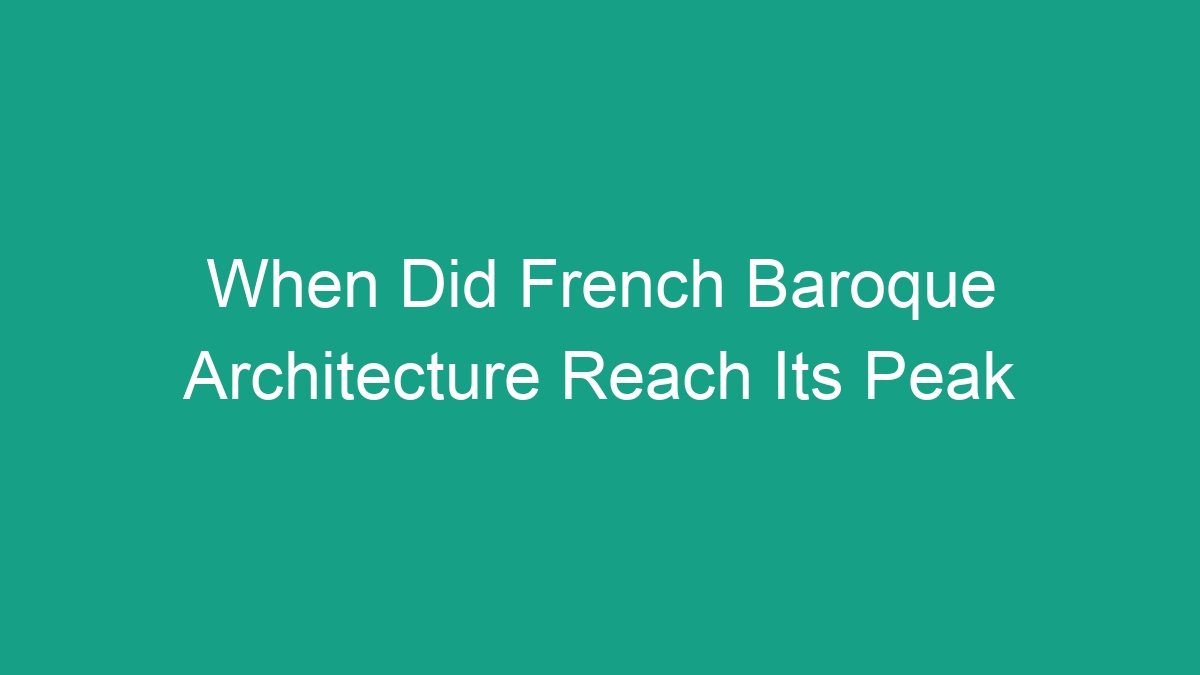
Introduction to French Baroque Architecture
French Baroque architecture is a style that emerged in France during the late 16th century and lasted throughout the 18th century. It is characterized by its grandeur, opulence, and ornate designs. The style became popular during the reign of Louis XIV and reached its peak during his reign and that of his successors. French Baroque architecture is revered for its lavish decoration, monumental scale, and meticulous attention to detail.
The Development of French Baroque Architecture
The emergence of French Baroque architecture can be attributed to several factors:
– Influence of Italian Baroque: French Baroque architecture was heavily influenced by the Italian Baroque style, which was characterized by grandeur and dynamism. The French architects adapted and modified the Italian style to suit the tastes of the French monarchy and the prevailing artistic sensibilities of the time.
– Patronage of the French Monarchy: The French kings, especially Louis XIV, were enthusiastic patrons of the arts and architecture. They commissioned numerous grand building projects to showcase their power and magnificence, which led to the flourishing of French Baroque architecture.
– Development of Formal Garden Design: The formal gardens of the French châteaux, such as Versailles, played a significant role in shaping French Baroque architecture. The elaborate and symmetrical layout of these gardens influenced the design and layout of the buildings themselves.
Key Characteristics of French Baroque Architecture
French Baroque architecture is known for several distinct features:
– Grandeur: Buildings in the French Baroque style are often imposing and impressive, with monumental facades, grand staircases, and soaring domes.
– Ornate Decoration: French Baroque buildings are adorned with intricate and lavish decoration, such as elaborate stucco work, sculptural details, and gilded accents.
– Symmetry and Balance: The design of French Baroque buildings emphasizes symmetry and balance, with an emphasis on creating harmonious and proportionate compositions.
– Use of Classical Elements: French Baroque architecture often incorporates classical motifs and elements, such as columns, pediments, and pilasters, to evoke a sense of classical grandeur.
– Integration with Landscaping: French Baroque buildings are designed to harmonize with their surrounding landscape, often featuring formal gardens, terraces, and outdoor spaces that are carefully integrated with the architecture.
The Peak of French Baroque Architecture
The peak of French Baroque architecture can be pinpointed to the reign of Louis XIV (1643-1715) and the period following his rule:
– Reign of Louis XIV: During the reign of Louis XIV, French Baroque architecture reached its zenith with the construction of the Palace of Versailles. The palace and its grounds served as the ultimate expression of the style, showcasing the grandeur and opulence of French Baroque design.
– Expansion Under Louis XV: The influence of French Baroque architecture continued to grow during the reign of Louis XV, with the construction of the Petit Trianon and other opulent châteaux. The style became more refined and showcased a greater emphasis on decorative details and interior design.
– Transition to Rococo: Towards the end of the 18th century, French Baroque architecture began to transition into the Rococo style, which was characterized by a lighter and more ornate aesthetic. This marked the end of the peak period of French Baroque architecture.
The Legacy of French Baroque Architecture
The legacy of French Baroque architecture can be seen in several aspects:
– Influence on European Architecture: French Baroque architecture had a profound influence on the development of architecture across Europe, particularly in countries such as Germany, Austria, and Russia.
– Preservation of Landmark Buildings: Many of the iconic French Baroque buildings, such as the Palace of Versailles and the Palace of Fontainebleau, have been preserved and are now UNESCO World Heritage Sites, ensuring their continued legacy.
– Continued Inspiration: The grandeur and opulence of French Baroque architecture continue to inspire contemporary architects and designers, influencing the design of grand public buildings, luxury residences, and cultural institutions.
Frequently Asked Questions
Q: What are some notable examples of French Baroque architecture?
A: Some notable examples of French Baroque architecture include the Palace of Versailles, the Palace of Fontainebleau, the Château de Vaux-le-Vicomte, and the Church of Les Invalides in Paris.
Q: What distinguishes French Baroque architecture from other Baroque styles?
A: French Baroque architecture is distinguished by its emphasis on formal grandeur, its use of classical elements, and its integration with formal gardens and landscaping.
Q: How does French Baroque architecture continue to influence contemporary design?
A: The opulence and grandeur of French Baroque architecture serve as a source of inspiration for contemporary architects and designers, particularly in the design of grand public buildings, luxury residences, and cultural institutions.
As we reflect upon the peak of French Baroque architecture, it is evident that the style continues to captivate and inspire audiences around the world. The grandeur and opulence of this architectural movement solidify its place in history and maintain its influence in modern design.



